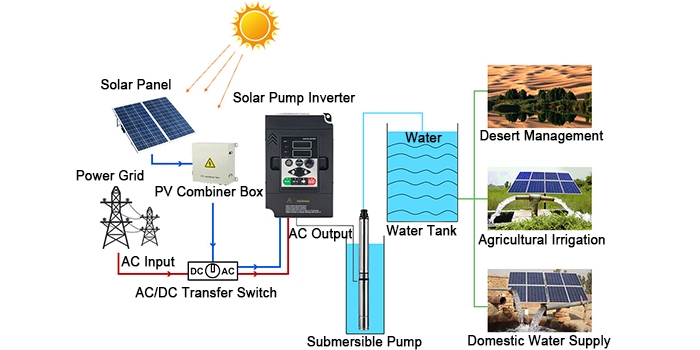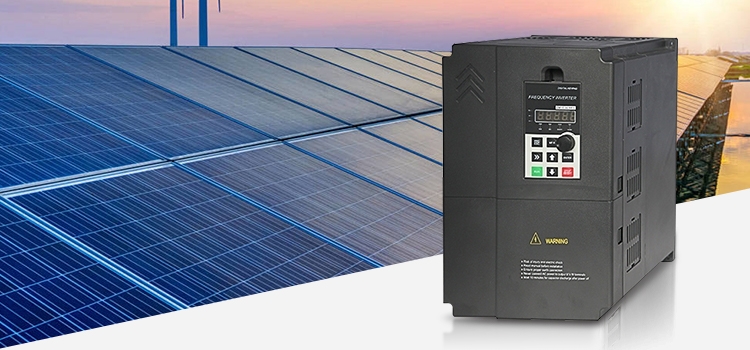With the global shift toward renewable energy and the rapid adoption of sustainable power solutions, solar water pump systems have become increasingly popular in agricultural irrigation, livestock water supply, and rural household use. At the heart of these systems lies the solar pump inverter, a key component that connects solar panels to the water pump and plays a critical role in ensuring system efficiency and reliability.
So how does a solar water pump inverter work? What are its internal mechanisms and control strategies? In this blog post, we’ll break down the working principles of a solar pump inverter and help you better understand its operation and functions.
Overview of a Solar Water Pump System
Before diving into the inverter’s functionality, Home Power Inverter has to first introduce the basic components of a solar-powered water pump system for you. A typical system consists of the following:
- Solar panels: These capture sunlight and convert it into DC electricity, serving as the primary energy source.
- Solar pump inverter: This device converts the DC output from the panels into AC electricity for the pump and manages system operation.
- Water pump: This can be a submersible pump, centrifugal pump, screw pump, etc., responsible for drawing water from the source.
- Water storage (optional): Tanks or reservoirs store the pumped water for use throughout the day.
- Sensors and control units (optional): These provide real-time monitoring and feedback based on water level, pressure, or temperature.
In this system, the solar pump inverter acts as a bridge—efficiently adapting to fluctuating solar input while ensuring smooth and stable pump operation.

Key Functions of a Solar Pump Inverter
A solar pump inverter (also known as a solar VFD for pump control) is responsible for several critical tasks:
- DC to AC conversion: It transforms the unstable DC electricity generated by the solar panels into AC power suitable for driving pumps.
- MPPT (Maximum Power Point Tracking): It continuously tracks the optimal voltage and current from the solar panels to maximize energy output.
- Frequency and voltage regulation: Depending on the type of pump (single-phase or three-phase), it adjusts the output frequency and voltage to provide soft start and overload protection.
- System protection and smart control: Built-in features like overvoltage, undervoltage, overload, and dry-run protection help extend the lifespan of both the pump and inverter.
Working Principle of a Solar Pump Inverter
The operation of a solar inverter for water pump applications can be broken down into several core stages:
- Solar Input and Data Sampling: The inverter receives DC power from the solar panels. Because solar irradiance varies in real time (due to weather, time of day, and seasons), the voltage and current from the panels fluctuate constantly. The inverter uses internal sampling circuits to continuously monitor the input voltage, current, and power to provide accurate data for MPPT control.
- MPPT (Maximum Power Point Tracking): Solar panels operate most efficiently at a specific voltage and current—known as the maximum power point (MPP). The inverter runs an internal MPPT algorithm (such as Perturb & Observe or Incremental Conductance) to track and adjust the input voltage to ensure the system consistently extracts maximum solar power. The typical MPPT process includes: Measuring current voltage and current to calculate power; Comparing with previous measurements to determine power change; Adjusting voltage direction based on gain or loss; Repeating the process to lock onto the optimal point. This is a core feature of any high-quality MPPT solar controller inverter.
- DC-DC Boost or Buck Conversion (in some models): Some solar pump inverters include a DC-DC stage to stabilize the input voltage. This is especially important for high-power systems or when the panel voltage does not match the pump’s input range. If the voltage is too low, the inverter boosts it; If too high, it steps it down. This regulation extends the working voltage range of the system and improves compatibility.
- DC-AC Inversion: Once stabilized, the DC electricity enters the inverter section. Using high-frequency PWM (pulse width modulation) technology, switching devices like IGBT or MOSFET convert the DC power into high-frequency square waves. These are filtered into smooth AC sine wave output, typically: 220V or 380V (depending on system setup), Adjustable frequency (0–50Hz) to control pump speed. This step enables the solar system to run standard AC pumps efficiently.
- Pump Start-up and Operation Control: To prevent sudden current surges, the inverter initiates soft start, gradually ramping up frequency and voltage to bring the pump online smoothly. Based on inputs from water level sensors, pressure switches, or flow meters, the inverter can intelligently manage pump operation, such as: Pausing during low water conditions; Resuming during optimal sunlight; Automatically shutting off when the storage tank is full. Even in low-light conditions or cloudy weather, the inverter adjusts output to allow for low-speed pumping, improving daily water yield.

Intelligent Control Features
Modern solar pump controllers are equipped with smart control functions to handle complex field conditions, such as:
- Auto start/stop: Starts or stops the pump based on solar irradiance, voltage, or water source conditions.
- Water level control: Coordinates with float switches or probes to stop pumping when tanks are full or sources are low.
- Dry-run protection: Detects when no water is being pumped and automatically halts operation to protect the system.
- Current limiting and frequency adjustment: Prevents overloading during sunlight fluctuations or pump blockages.
- Remote monitoring (optional): Premium models offer RS485 communication (such as our 0.75 kW three-phase solar water pump inverter) or wireless access for app/online monitoring, fault alerts, and system management.
Types of Solar Pump Inverters
Based on output and application, solar pump inverters are generally classified into:
- DC pump inverters: Drive DC pumps directly, offering high efficiency but requiring precise system matching.
- AC pump inverters: Output standard AC voltage for single- or three-phase pumps, offering broader compatibility.
- Hybrid inverters: Accept both solar input and grid/generator power, ideal for areas with unstable sunlight or as backup during cloudy periods.
Conclusion
The solar water pump inverter is truly the "brain and heart" of a solar pumping system. Its efficient operation determines how well the system performs overall. By leveraging power electronics, MPPT algorithms, and intelligent control, the inverter not only converts energy efficiently but also ensures safe, reliable, and flexible operation in real-world conditions.
As technology continues to advance and costs decrease, solar-powered pump systems will expand into even more sectors—offering smart, eco-friendly solutions for agriculture, water conservation, and rural development.
If you're planning to implement a solar pump solution, understanding how the inverter works is crucial for proper system selection and long-term maintenance. Stay tuned for more expert content, or contact us to learn more about choosing the right solar pump inverter for irrigation or domestic water use.
